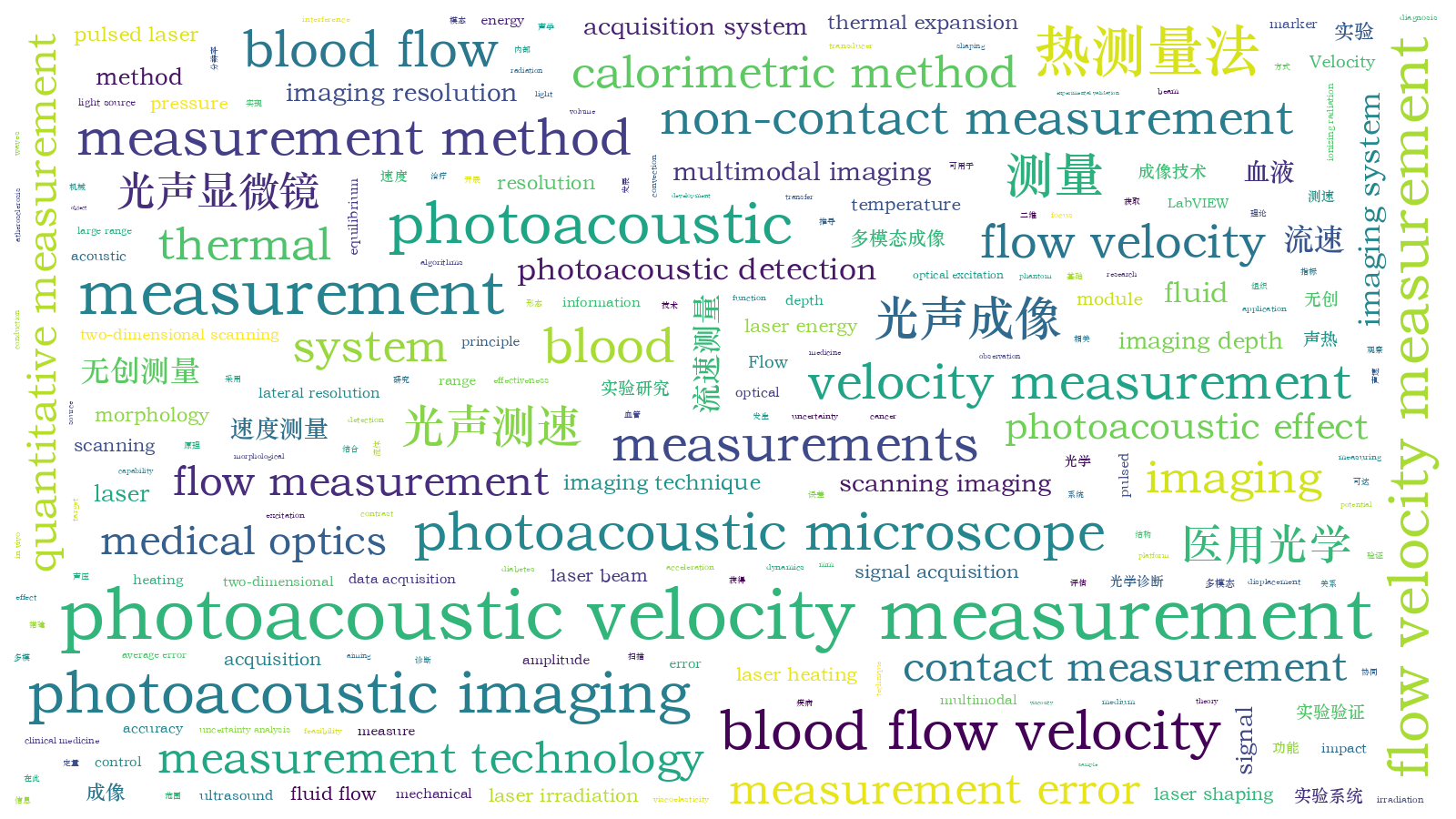基于光声热测量法的血液流速无创测量
Photoacoustic imaging is a multimodal imaging technique that integrates principles of optics and acoustics, enabling the observation and acquisition of structural and functional information within tissues. Blood flow velocity serves as a crucial indicator for evaluating vascular function and is closely associated with the occurrence and development of diseases. Accurate measurement of blood flow is particularly crucial for the diagnosis of various conditions, such as burns, stroke, atherosclerosis, diabetes, and cancer. Furthermore, the dynamics of blood flow have a significant impact on the effectiveness of pharmaceutical interventions in the human body, which emphasizes the importance of precise quantitative measurement of blood flow in clinical medicine. Photoacoustic measurement technology is a non-contact measurement approach based on the photoacoustic effect. It involves the application of pulsed laser energy to the target object, inducing thermal expansion and pressure waves that generate acoustic signals. The resulting acoustic signals are detected by an ultrasound transducer, and relevant algorithms are applied to measure fluid flow information (Fig. 1). Compared with traditional flow velocity measurement techniques, photoacoustic measurement technology offers higher resolution, greater imaging depth, increased contrast, and does not involve ionizing radiation.
This study employs the photoacoustic thermal measurement method to measure blood flow velocity. The principle of the photoacoustic thermal measurement method is rooted in the dependence of the photoacoustic signal amplitude on the temperature of the flowing medium. This dependence can be modulated through external heating and is influenced by the flow velocity. In the photoacoustic thermal measurement method, a pulsed laser beam is directed onto the fluid (blood). The absorbed optical energy induces a transient increase in local fluid temperature, creating a "thermal marker" and generating a corresponding ultrasound signal. Due to the acceleration of thermal transfer caused by fluid motion, the equilibrium temperature of the "thermal marker" varies at different flow velocities under the same laser irradiation, and it is correlated with the flow velocity. In this study, the fundamental theory for measuring blood flow velocity is deduced based on the thermal measurement method, establishing the relationship between velocity and the average photoacoustic signal amplitude. Furthermore, an experimental system for photoacoustic velocity measurement and imaging is constructed (Fig. 2). Utilizing LabVIEW for centralized control of the mechanical displacement stage and the signal acquisition system, experiments on photoacoustic velocity measurement and imaging are being conducted.
Through experimental investigation, quantitative relationships between photoacoustic pressure and fluid velocity are obtained. The study includes uncertainty analysis, and the experimental validation reveals an average measurement error of 8.2% for flow velocity within a relatively large range (0-200 mm/s) (Figs. 7 and 8), ascertaining the accuracy of the measurement. The lateral resolution of the imaging system is determined to be 10 μm (Fig. 9). Subsequent experiments involve two-dimensional scanning imaging, confirming the structural imaging capability of the system (Fig. 10). Finally, morphological and velocity photoacoustic co-measurements are conducted, demonstrating the system multimodal imaging functionality (Fig. 11). While the study does not consider the potential impact of vascular viscoelasticity on results, its underlying principle is based on the thermal equilibrium of laser heating, conduction, and blood convection within the heated volume, mitigating the effects of blood being a non-Newtonian fluid with shear forces and viscosity. Challenges in photoacoustic blood flow measurement, including measurement depth and signal interference, will be the focus of future research. Additionally, further experiments under different conditions, such as phantom and animal blood flow measurements, will be conducted to validate the feasibility of this method.
This study develops a thermal measurement-based photoacoustic experimental system for concurrent measurement of vascular morphology and blood flow velocity. The system utilizes a single light source to achieve synchronized measurements of vascular morphology and flow velocity. The experimental setup comprises optical excitation and laser shaping modules, photoacoustic detection module, sample pool, scanning motion module, and data acquisition module. The LabVIEW platform is employed for the control and storage of photoacoustic data. Through in vitro single-point velocity experiments, quantitative relationships between the photoacoustic pressure and fluid velocity are established. The system velocity measurement average error is validated to be 8.2%, with a maximum measurable velocity range of up to 200 mm/s. Building upon this foundation, a two-dimensional mechanical scanning approach is implemented to achieve concurrent photoacoustic morphology and flow velocity measurements with a resolution of 10 μm. Subsequent work will involve in vivo measurements of blood flow velocity and vascular morphology using this experimental system, aiming to further enhance the system imaging resolution and velocity measurement accuracy.
许路寒, 张浩, 李东, 陈斌, 郑玉萍, 姚亮. 基于光声热测量法的血液流速无创测量[J]. 中国激光, 2024, 51(3): 0307205. Luhan Xu, Hao Zhang, Dong Li, Bin Chen, Yuping Zheng, Liang Yao. Non-Invasive Measurement of Blood Flow Velocity Based on Photoacoustic Calorimetric Measurement[J]. Chinese Journal of Lasers, 2024, 51(3): 0307205.







